This is my first ever football breakdown or blogpost and I’m excited to have joined 18stripes. I’ve been an x and o’s junkie for years, so I hope this turns out well. I have made condensed cutups of Notre Dame games in the past and you can view some of my video work at https://www.youtube.com/user/Downinthebend/ . and my twitter at https://twitter.com/downinthebend .
For reasons that remain unclear, Brian Kelly did not involve Deshone Kizer significantly in the run game against Michigan State (Kizer was involved in around 8 run plays, as opposed to well over 20 in previous games). Of the 8 plays, three were touchdowns (one was called back) and another was a 30 yard gain. This lack of involvement was a perplexing decision as Michigan State often plays a type of defense where it is important to have another “blocker”: Harlon Barnett and Mike Tressel base out of a quarters look where the box is stacked and the safeties and corners are simultaneously responsible for the deep third of the field and in stopping the run. This defense starts to break down when those two responsibilities are put in conflict, such as a run pass option, or playaction.
My theory is that Brian Kelly now considers Deshone Kizer irreplaceable and wants to minimize his injury risk. I’ll be paying close attention to his involvement in the run game over the next few weeks. Instead of the QB run game, Brian Kelly prefered to use inside zone and power to attack Michigan State. However he introduced a wrinkle to the inside zone in the form of the “split zone”, or technically the “slice”.
What is the Split Zone?
The Split Zone adds a trap to the normal inside zone in the form of a h-back / tight end (in Notre Dame’s case Durham Smythe) from the playside blocking a lineman on the backside. The split zone is used from the NFL to college, but a variation of it (known as the wham) was made particularly famous in college under Urban Meyer’s Tim Tebow offenses of years past. It is ubiquitous in the National Football League, and the following play diagram is from Charlie Weis’s 2004 playbook.
Notre Dame lined up or motioned Durham Smythe (the Te or H-back) into a single wing formation with either a 2×2 or 3×1 receiver setup. A shotgun wing look has Durham Smythe about a yard behind and to the right/left of either Mike McGlinchey (the left tackle) or Alex Bars (the right tackle).The weak-side end is left unblocked exactly as if it is a zone read. This slows down the end’s reaction as it adds a false read key (generally defenses prefer for the RB to carry the ball in an inside zone read). Next, the strong-side TE pulls across formation and traps the DE. The linemen are simply blocking inside zone rules. So having said that, lets look at several of the plays.
Split Zone Run #1
In this play Durham Smythe (#80) was motioned from a trips look into a wing look. Notre Dame has 6 blockers and Michigan State has 6 defenders so it is a favorable run look for the offense. Alex Bars (#71) blocks the strongside defensive end. Colin McGovern (#62) and Sam Mustipher (#53) double team the strongside defensive tackle, and then Colin moves onto the next defender ahead of him. Quenton Nelson (#56) and Mike McGlinchey (#68) double team the weakside defensive tackle after which Mike moves to block the weakside outside linebacker. The weakside defensive end is left unblocked and acts as if he is playing the qb before he is trapped by Durham.
The Michigan State line is pushed back a little bit, with the exception of Malik McDowell (#4) who manages to lose almost no ground even in the face of a double team and gets a hand on Josh Adams to stop the Irish for a gain of about three yards. If Colin McGovern had double teamed Malik McDowell a little longer, or if Malik was less of a star than he is, this play easily could have gained more than five yards.
Watch the whole play here:
Split Zone Run #2
Notre Dame ran this play again in the middle of the 3rd quarter.
Notre Dame again runs this blocking scheme, however this time Michigan State has 7 defenders in the box (the weakside outside linebacker rotated into the box right before the snap) and Notre dame has 6 blockers. Alex Bars (#71) blocks the strongside defensive end, Colin McGovern (#62) and Sam Mustipher (#53) again double team the strongside defensive tackle before Colin moves onto the strongside outside linebacker. Quenton Nelson (#56) and Mike McGlinchey (#68) likewise double-team the weakside defensive tackle. Durham Smythe (#80) pulls across the formation in order to block the weakside defensive end.
However, it wasn’t to be. The weakside outside linebacker was unaccounted for and blows up the play in the backfield for about a loss of two yards. Durham Smythe is not even able to make his block of the weakside defensive end before the play is over. In spite of this, the offensive line blocked fantastically and the play looked to be around an 8 yard gain if Notre Dame had had the same amount of blockers as defenders. This was a play that really could have benefited from Kizer’s run threat, as if the defensive end was read and Durham blocked the weakside outside linebacker a large gain would be almost assured.
Watch the play here:
Split Zone Triple Option Pass
The split zone had little success against the stacked boxes of the MSU defense, but it has an interesting complement: the triple option pass. In this play, the TE fakes a block on the weakside defensive end and instead blocks the weakside safety. The quarterback actually reads the defensive end like a normal inside zone read. The outside receiver runs a go route to constrain the cornerback from stopping the quarterback run, however the corner decided to leave his man so Kizer completed probably the easiest 30 yard gain of his career. MSU was likely in a quarters defense here.
In this complement of the split zone, the offensive line blocks the same zone look as before: Alex Bars (#71) blocks the strongside defensive end, Colin McGovern (#62) blocks the middle linebacker, Sam Mustipher (#53) blocks the strongside tackle, Quenton Nelson (#56) and Mike McGlinchey (#68) block the weakside tackle. Durham Smythe (#80) pulls across the formation in order to setup a block on the weakside safety. Kizer reads the weakside defensive end, who is unblocked, to determine whether to hand the ball or keep it. Equanimeous St. Brown (#6) runs a go route to put the corner in conflict.
For Michigan State, the defensive end crashes the mesh, the corner presses St Brown, and the weakside safety rotates to fill in the gap left by the defensive end.


The corner chooses to attack the quarterback and Kizer completes an easy pass to St. Brown.
Watch the play here:
Kizer was running toward the left and had to complete a pass away from his momentum leading to a bit of a bad (but good enough) throw. I do not believe that this play would have been able to score a touchdown if it was run in the opposite direction: the receiver was not running a true “go” route, but instead was looking to receive the pass the entire time, so he was unable to run full speed ahead.
Notre Dame did not end up utilizing the split zone to a significant degree likely because of the stacked boxes and the score becoming out of hand. However the added wrinkle and the complementing triple option pass will likely be used in future games especially if the lack of involvement from Kizer in the run game continues.
Additionally, it has been said that the offensive line played particularly badly versus Michigan State. It is true they played bad on several plays, however after re-watching the offense several times, time after time Notre Dame had one less blocker than Michigan State had defenders in the box. If Brian Kelly had utilized Kizer in these run plays it is likely that we would have seen the same production as previous games.

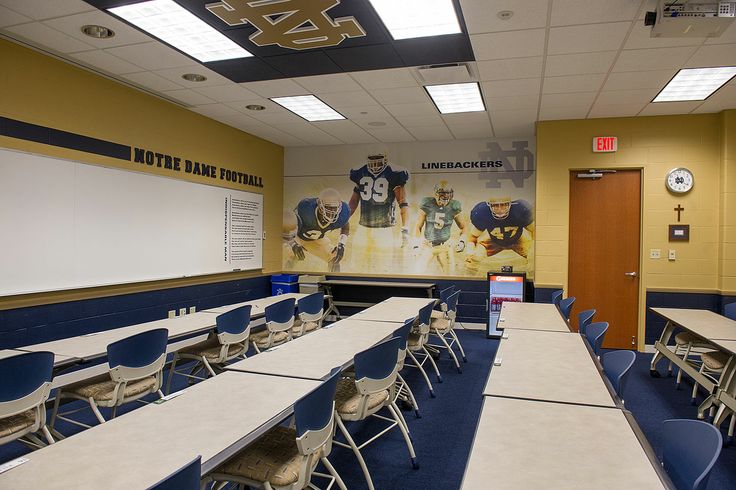
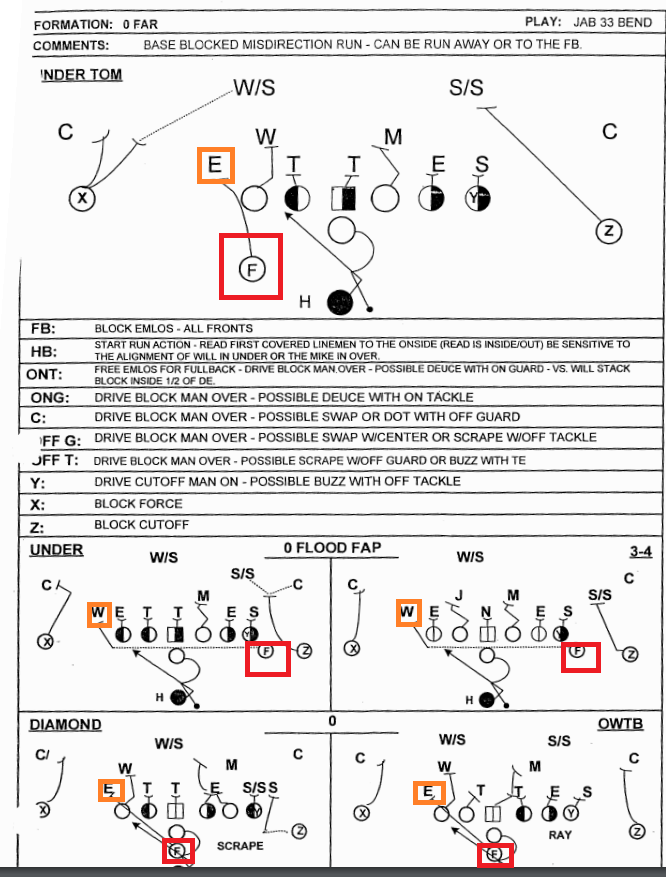
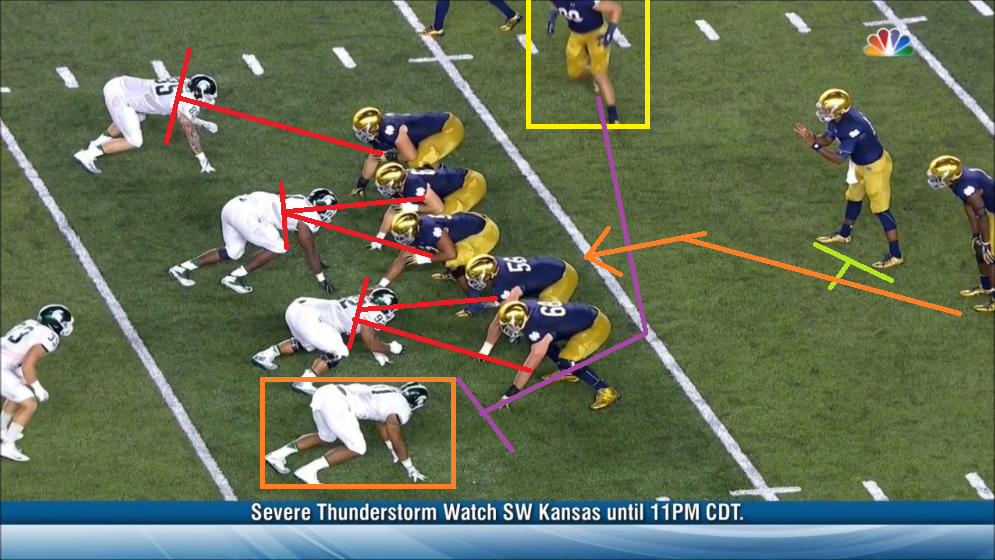



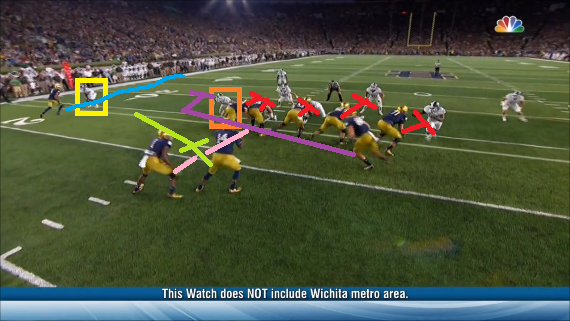



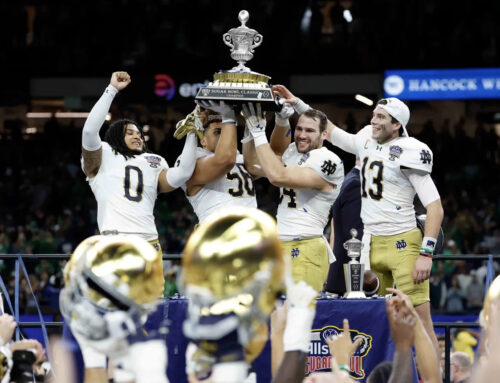
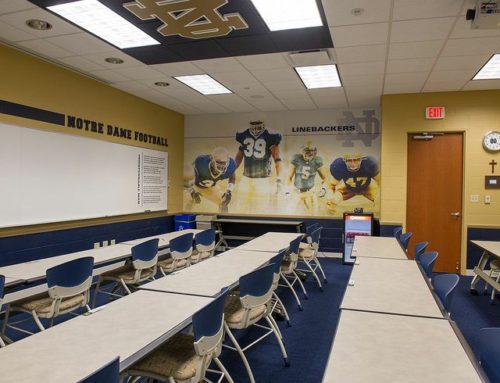
Thanks for this downinthebend!
Nice work! I really like the way you add the notes from the still shots to the beginning of the you tube clip. it really helps. Thanks for doing this!
Thanks, I recently found out how to do that, do you think it could be better by adding a text note to each marked up still, or is it fine as is?
I’d say good as is. Appreciate the insights!
Thanks downinthebend. Great stuff!
I always enjoy reading these breakdowns.
Great article!